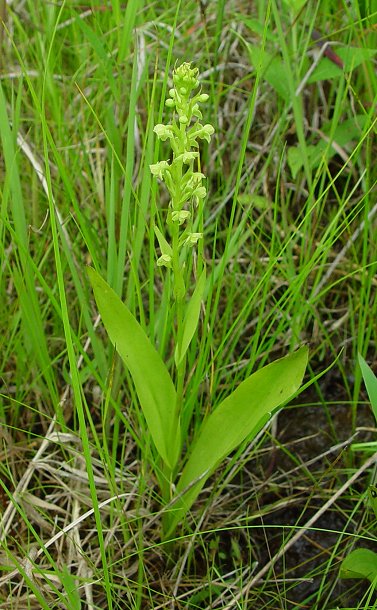Platanthera flava (L.) Lindl.
Pale Green Orchid

Native
CC = 10
CW = -3
MOC = 23
SRank = S2
© DETenaglia
Platanthera flava (L.) Lindl.Pale Green Orchid | |
 |
Native CC = 10 CW = -3 MOC = 23 SRank = S2 |
© DETenaglia |
|
Family - Orchidaceae Habit - Perennial forb from a fascicle of fleshy, sometimes tuberlike roots.
Stems - Erect, to 60 cm, herbaceous, simple, single or double from the base, glabrous, with vertical ridges formed by decurrent leaf and bract tissue, green. Leaves - Alternate, simple, entire, sessile, sheathing, 2-5 per stem and grading into the reduced bracts subtending the flowers, glabrous, narrowly elliptic-lanceolate, acute at apex, the largest with blades 12 cm long, 2 cm broad, dull green above, slightly more shiny below, the midribs deeply impressed adaxially, expressed abaxially.
Inflorescence - Terminal spike to 10 cm long, bearing 10-30 flowers. Axis glabrous. Flowers subtended by lanceolate bracts, these shorter or longer than the flowers (depending on the variety), green, glabrous, entire.
Flowers - Sepals all similar, 2-4 mm long, green, ovate to broadly elliptic, usually somewhat pouchlike, the upper sepal forming a shallow hood over the column. Lateral petals mostly arching upward and inward, overlapping under the upper sepal. Lateral petals 2-4 mm long, ovate to elliptic, the tips pointed, yellowish green. Lip 3-6 mm long, ovate, the tip broadly rounded, the margins somewhat irregular to entire, unlobed but with a pair of teeth at the base and a low tubercle in the center, green to yellowish green. Spur 5-6 mm long, not strongly curved. Column 1.5-2.0 mm long, yellowish green, with 1 stamen, the anther with 2 pollen sacs separated by a thin or broad connective, each arm of which bears a viscidium (a sticky structure along the arm), the viscidia 1 mm apart, positioned so as to face more or less forward (parallel to each other). Pollen white.
Fruits - Capsules ascending, 5-25 mm long, elliptic in outline, strongly ribbed. Flowering - May - September. Habitat - Bottomland forests, wet prairies. Origin - Native to the U.S. Other info. - This species can be found scattered throughout Missouri but is relatively uncommon. Beyond Missouri its range extends across the eastern half of the continental U.S., but nowhere is it particularly common. With both flowers and foliage of a greenish color, the plant tends to blend in with surrounding vegetation and is easy to overlook. Once discovered, it is easy to identify from its characteristic green flowers, which have short spurs and an undivided lower lip. Photographs taken at Taberville Prairie, MO., 6-7-03 (DETenaglia); also at Tingler Prairie Natural Area, Howell County, MO, 6-10-2021 (SRTurner). |